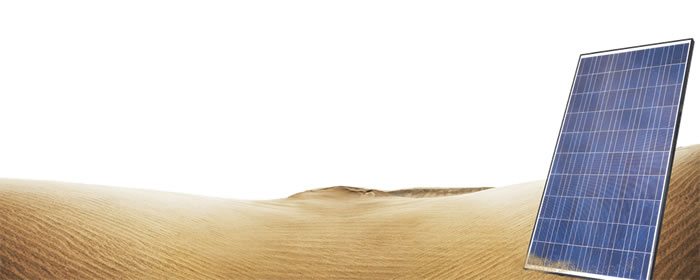Solar energy, today, is being produced all over the world. Nonetheless, it is particularly in the regions in which the sun has the maximum power that modules are often exposed to extraordinary stresses. Extreme temperatures and temperature fluctuations, high atmospheric humidity, strong winds and sandstorms.
In several cases, off grid deployment is also necessary here. J.v.G. has dedicated itself to developing module technologies that are adapted specifically to withstand these extreme conditions.
The Desert Module Technology TM achieves with the help of the so called high-power temperature process considerable performance enhancement versus comparable modules.
General benefits of the J.v.G. desert module (HPTP Process Technology)
· High temperature up to 125 °C continuous, 145 °C peak
· Long service life: up to 75 years, guaranteed 45 years
· 100 % recyclable
· Higher yield
· At present, already 5 % more power than conventional modules
· PID free
PID: Potential-induced degradation stands for the voltage-related degradation in power in crystalline photovoltaic modules cause by so-called leakage currents. In case of high system voltages in the region of 1,000 Volts, there may be leakage current in the module, i.e. charge carriers flow through the embedded material and the backside film. This may lead to electrochemical corrosion and thus, causes loss of power in the module.
The effect occurs particularly at high temperatures and high levels of atmospheric humidity (see the diagram on the right); it may cause loss in power of up to 80 %.
Desert step 1 – crystalline mono and multi-module
In glass / film modules, the solar cells lie behind a wafer made of highly transparent and hardened glass. In addition, the J.v.G. desert modules have a special anti-reflex coating, which enhance the light transmission considerably. Moreover, they have a specially developed film (laminate package), which has been designed for extreme temperatures and humidity. They are protected on the back side with a robust Tedlar film. A robust aluminium frame provides stability and facilitates installation.
The Benefits
· Highly robust aluminium frame (45 mm, snow load class III)
· Maximum energy output and high annual energy yield
· PID free
Desert step 2 – glass / glass – modules
Conventional modules are covered on the front side by transparent glass and the rear side consists of a plastic film. In glass / glass modules, the film at the rear is replaced by a second glass panel. This makes it highly robust and durable.
The benefits
· 2 mm cover glass, 2 mm glass on the back side
· Designed for deployment worldwide
· large temperature range and high atmospheric humidity
· Extreme stability and durability
· Precise symmetry
· No cell breakage
· Less material and low weight, 10 kg/m2
· Frameless: better load distribution, less risk of breakage with wind and snow loads
· Simplified sub-construction (ideal for car ports, glasshouses and in-roof systems)
· Flexibility with the design and dimensions
· PID free
Glass / film modules cooled as well as glass / glass modules cooled
These modules have all the benefits of the glass / film design variants. At the same time, they counter the fact effectively that the efficiency of modules diminishes with rising temperature. By cooling, the utilisation may be enhanced by up to 25 %.
Desert step 3 – flexible modules
A polymer film encases the silicon cells on the front and back sides and makes JW Flex capable of movement in all directions. These modules, in fact, may be placed on round surfaces. Moreover, they are ultra light-weight. Particularly in the case of angular incidence of sunlight, flexible modules deliver a high yield. This is attributable to the spherical arrangement of the silicon.
J.v.G. has already applied for different patents with respect to this technology. The module is as easy to install as JW Flex is diverse in its application: They are suspended at eyelets or fastened with screws to the subsurface.
The benefits
· High temperature up to 125 degrees continuous, 145 degrees peak
· Long life, up to 75 years, guaranteed 45 years
· 100 % recyclable
· High level of efficiency (10 %)
· Unmatched response in the shade
· Flexible
· Almost unbreakable!
· Ideal for special applications, BIPV
· Absolutely flexible in all directions
· Ultra light-weight (approx. 3 kg/m2)
· Extremely heat-resistant
· No sub-construction necessary
· Possible in different sizes (A3, A4 and A1)
· Very high yield particularly with angular incidence of sunlight
· Maximum energy output and high annual energy yield
Desert step 4 – nanotechnology
Why nanotechnology?
The power of a solar cell can be enhanced by 20 % with the help of nano-coatings, and the module power can be increased by 5 %. So far, solar modules have been able to convert only a certain range of the sun spectrum to electrical energy. With the help of their very special characteristics, the nano-coating applied by us bundles all incident rays. This has already been demonstrated on a laboratory scale and implemented successfully. The entire cell has been realised on a surface of 5 x 3 cm.
The benefits
· nano coating (glas); + 25% yield
· flex desert module; 2kg / module
For more information visit www.jvg.thoma.de

